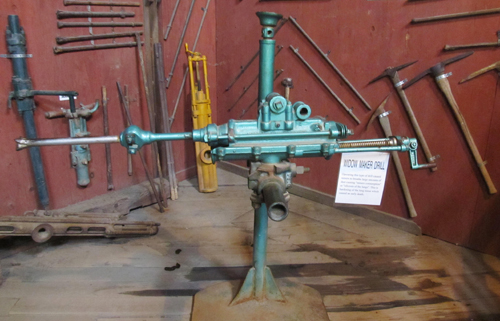Saturday, February 15 2014
Among the many improvements made to mining technology during the Industrial Revolution, perhaps the most important involved drilling and blasting. In the early days, black powder, a relatively low-power explosive was the only blasting agent available. To use it, holes had to be pounded into rock by hand. Working in teams of two, one miner would hold a pointed steel chisel while the other hit it with a sledge hammer. Each hole had to be hand drilled to six or eight inches in depth. Needless to say, this was slow, tedious, and tiring work. During a 10-hour shift, a team could typically drill, load, and fire black powder charges in only eight or 10 holes. Depending on the size of the mine tunnel, that single blast could bring down three quarters to two and a half tons of rock. Dynamite, an explosive five times more powerful than black powder, was invented in 1866 by Swedish chemist, Alfred Bernhard Nobel (the Nobel Prizes awarded today were named after him). Nobel held 350 different patents; dynamite is his most famous claim to fame. By the mid 1870s, dynamite had largely replaced black powder in the mines.
Unfortunately, thousands of hard rock miners died before J. George Leyner of Denver, Colorado invented a better machine drill that all but eliminated deadly silicosis. The improved drill forced water into the drill hole and created a harmless mud out of the drill shavings. The mud acted as a very efficient wet grinding compound while also cooling the drill bit, and the flow of water flushed out the drill hole. Leyner patented his mechanism in 1897. This type of drill hasn’t changed much over the years, and is still used in modern-day hard rock mines. |
|
Nugget of News Blog |






 Around the same time period, pneumatic machine drills were first developed. Compressed air to power the drills was piped underground from large steam-powered compressors located at the surface. Machine drills could accommodate five to six foot drill steels that were capable of drilling three to four foot holes into sold rock in a matter of minutes. This new drill increased the tonnage of rock that could be blasted by two-man teams of miners to between four and 10 tons per shift. But, the new technology was not without hazards— namely the disease of silicosis. Machine drilling created clouds of razor sharp microscopic silica dust that miners breathed into their lungs. It took only a few years of operating this drill for a miner to develop this incurable disease.
Around the same time period, pneumatic machine drills were first developed. Compressed air to power the drills was piped underground from large steam-powered compressors located at the surface. Machine drills could accommodate five to six foot drill steels that were capable of drilling three to four foot holes into sold rock in a matter of minutes. This new drill increased the tonnage of rock that could be blasted by two-man teams of miners to between four and 10 tons per shift. But, the new technology was not without hazards— namely the disease of silicosis. Machine drilling created clouds of razor sharp microscopic silica dust that miners breathed into their lungs. It took only a few years of operating this drill for a miner to develop this incurable disease.